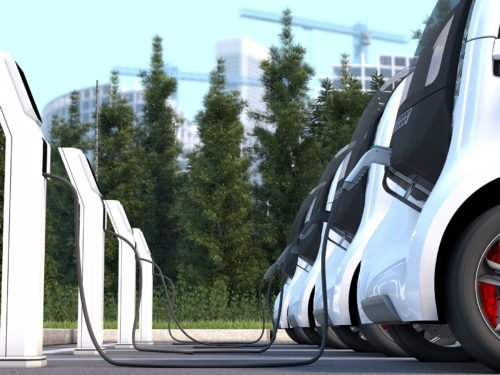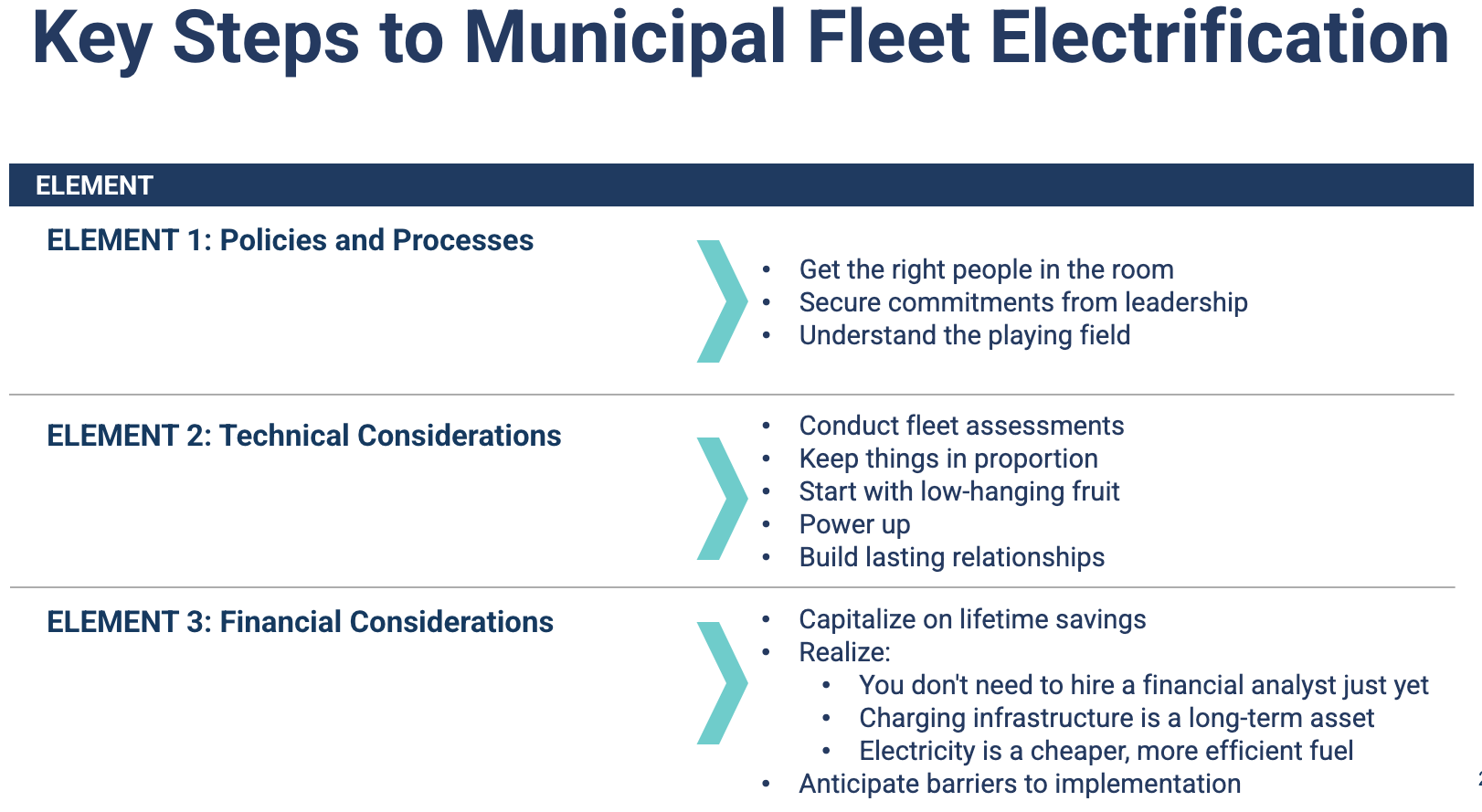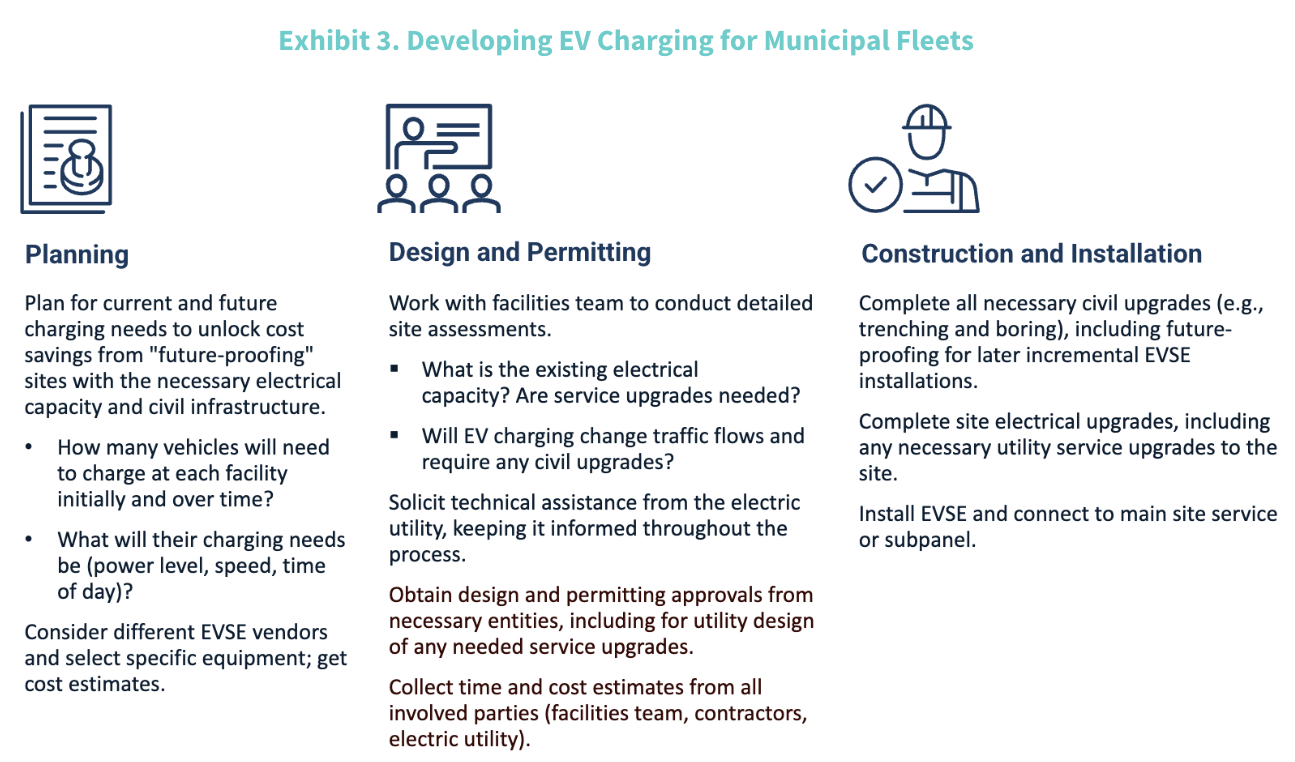
There’s Never Been a Better Time to Electrify Your Fleet
RMI distills steps local governments can take to improve public health and save money by electrifying their fleets.
The confluence of steeply declining battery costs, automaker announcements of new and varied electric vehicle (EV) models, and new federal funding presents a compelling opportunity for fleet operators to cash in on the dividends of electrification. EVs can lower operating costs, greenhouse gas emissions, and local air pollution, all while providing enhanced performance.
Both private and public fleet operators, including the approximately 3,000 counties and 36,000 municipalities or townships across the United States, are recognizing this opportunity and beginning to plan in earnest for EVs. However, many fleet managers do not have experience with EVs, leading to a variety of common questions. For example, what are some of the basic approaches and key decisions to consider regarding EV charging infrastructure? What role does the electric utility play? How do capital and operating costs between EVs and conventional vehicles compare over time? These new questions and required areas of expertise can serve as a meaningful impediment to fleet electrification, especially for local governments that may not have the staff or resources to explore each area thoroughly.
In recognition of this challenge, RMI recently conducted an eight-month workshop series for local governments in Texas, distilling what we’re calling the three key elements of fleet electrification: (1) policy and process steps essential for gaining support, (2) technical analyses needed for an effective and strategic transition, and (3) financial considerations critical to do so cost-effectively. Our new paper— How Cities and Counties Should Electrify Their Fleets — summarizes learnings from the workshop series, highlighting the most important practices for each of these three components of a successful fleet electrification strategy.
Policy and Process Steps
Just as the motivation for fleet electrification varies across jurisdictions, the particular processes and policies that influence this transition are inherently local. Securing buy-in from leadership based on their motivating factors can serve as the starting point for subsequently identifying the key process levers that must be pulled to transition your jurisdiction’s procurement to EVs. A good starting point is the implementation of a green fleet policy to establish the prioritization of EVs over internal combustion engine vehicles as the default approach. Another key planning consideration is simply to dedicate sufficient staff time and resources to supporting the transition; the challenges are far from insurmountable, but they will take time to work through, and the importance of securing leadership buy-in to spend that time should not be overlooked.
In most jurisdictions, however, one of the biggest challenges is figuring out how to make the finances pencil out, especially given that traditional procurement policies focus heavily on upfront costs. Identifying how to amend processes to fully realize lifetime cost savings from EVs is therefore the lynchpin of most successful fleet electrification strategies. To do so, a key resource will be civil servants across the different departments involved in the current process, as no one knows existing practices better than those who carry them out. These stakeholders — who should be engaged from the beginning — can help to identify the specifics of what needs to change to support EV procurement and charging infrastructure development, which often takes longer than many local officials realize.
Technical Analyses
There are many technical aspects to electrifying fleets, some of which can seem like huge barriers to overcome. EVs are a different technology than conventional internal combustion engine vehicles and have different technical considerations. However, following the structured path detailed in our report — from fleet assessment and right-sizing to identifying early candidates for electrification through to site evaluations and developing charging infrastructure in coordination with your facilities team and the local electric utility — enables a methodical approach for both your early electrification efforts and subsequent procurements as you transition larger portions of your fleet.
As local governments move through this process, key aspects to keep in mind relate to lead times and planning ahead. For example, engaging early and often with the electric utility is one of the best strategies to reduce delays and ensure projects are developed on schedule — identify any site-specific challenges early and find ways to work around them. Additionally, future-proofing your facilities with additional electrical capacity and make-ready components such as conduit and wiring to easily be able to add more EV chargers as your fleet transitions will save time and money in a few years. Getting a start on the infrastructure component of your strategy and envisioning both today’s and tomorrow’s charging needs is a winning strategy for any fleet manager serious about electrification.
Developing EV Charging for Municipal Fleets
Financial Considerations
Financing your fleet’s electric transition can seem like a daunting challenge, especially for those new to the process. However, several key strategies can help local governments make a case for the favorable economics of electrification and chart a cost-effective path forward.
- Planning ahead to apply for and utilize available federal and state incentive funding can be critical for addressing the upfront cost of EVs, which are often higher than conventional vehicles in today’s market. This requires seeking out funding opportunities, and submitting well-crafted applications to secure available incentives.
- Accounting for lifetime operational savings from lower fueling and maintenance costs also helps to offset any higher upfront capital costs for EVs. Total cost of ownership analysis allows for direct comparisons between different vehicles over their full useful lifetime, effectively recognizing these operational savings, unlike many conventional procurement processes which only consider upfront costs.
- Scaling procurement to access bulk discounts and utilizing innovative financing approaches can also significantly reduce the upfront capital burden and bring EV costs down to parity with — or even less than — conventional vehicles.
Finally, it is a best practice to engage with and learn from peer local governments that have had successful experiences procuring EVs cost-effectively through grant funding awards, cooperative purchases, and/or leasing contracts. Keep in mind: procuring the vehicles is often the hard part; the savings will follow.
Take Advantage of the Opportunity
Electrifying municipal fleets requires thoughtful planning, staff time and resources, and a commitment to exploring technology that is new to many stakeholders. However, the benefits are well worth the effort, and there has never been a better time to begin this transition. Current funding and incentive opportunities, paired with automaker commitments and growth in the EV market, make this opportunity more compelling than ever. The hardest part may simply be getting started. Our new guide — How Cities and Counties Should Electrify Their Fleets —aims to make that first step easier and serve as a resource for understanding what the end-to-end process can look like. Time to take the first step.

